 In collaboration with four research projects with a geographical focus on Ghana/Gulf of Guinea, East Africa, the Indian Subcontinent, Indonesia as well as Peru this two-day FAO web seminar served to share interesting research results about production, processing, marketing, consumption and governance aspects of the value chain of small, low-cost fish. The prime concern was how to ensure that people with little purchasing power could retain access to healthy fish food rich in micronutrients.
In collaboration with four research projects with a geographical focus on Ghana/Gulf of Guinea, East Africa, the Indian Subcontinent, Indonesia as well as Peru this two-day FAO web seminar served to share interesting research results about production, processing, marketing, consumption and governance aspects of the value chain of small, low-cost fish. The prime concern was how to ensure that people with little purchasing power could retain access to healthy fish food rich in micronutrients.
The introductory remarks by Nancy Aburto of the Food and Nutrition Division of FAO and Shakuntala Haraksingh Thilsted of WorldFish highlighted the importance of fish for a healthy diet, particularly of undernourished people whose numbers are estimated to have increased by up to 132 million as a result of the covid pandemic. Food for the most vulnerable and financially poor people must be safe and affordable. The highly bioavailable micro-nutrients in fish, such as vitamin A to prevent blindness and B12 to ensure healthy brain development and cognition in infants are among the reasons for a particular attention to fisheries products in available and accessible foods for financially poor people. Some of the smaller species can be eaten whole, thus avoiding any waste (see graph below, courtesy WorldFish). Dried fish in combination with vegetables and staples in the local diet, such as millet or rice can provide a well-balanced diet responding to local taste preferences.

In some places, safety concerns pertain to use of pesticides in dried fish used to prevent spoilage during drying. Other safety issues focus on microbes and parasites or the accumulation of aflatoxins. How to address such concerns while reducing postharvest losses in regions where electricity and ice are either unavailable or insufficient remains a challenge, which food technologists and practitioners continue to grapple with for decades.
The introductory debate also brought an acute challenge to the fore: Where industrial interests compete with small-scale fisheries for small, low-cost fish for fish meal and oil rather than human food that tends to push raw material prices up and may pose existential risks to people with small purses. It became thus clear from the beginning that the issues at stake had many technical, economic, ecological, social, justice and governance angles that needed a multifaceted response from the diagnosis to the search of adequate responses.
The seminar was structured in the following sessions, each with about an hour of presentations from different locations and perspectives, followed by a long enough Q&A session to allow for lively exchanges. The invitation with the programme is here. All sessions were recorded and will be uploaded on YouTube as soon as possible. In the following only a few snapshops are offered to give a flavour of the rich presentations and exchanges.
Session 1 Ecology and harvesting
Speakers were: Santiago de la Puente, Institute for the Oceans and Fisheries, UBC, Vancouver, Canada; Francis K.E. Nunoo, University of Ghana; Jeppe Kolding, University of Bergen, Norway; and Martin Pastoors, Pelagic Freezer-trawler Association, Netherlands.
 Santiago de la Puente opened with vistas on the biggest global fishery targeting the Peruvian anchoveta (Engraulis ringens) where the top seven companies account for some 60% of the catch earning perhaps as much as US$ one billion each. The rest is caught by smaller vessels which employ almost 250,000 people. The overwhelming majority of the catches are reduced to fish meal and oil as feed e.g. for aquaculture in China and Europe and much of the added value accrues outside of Peru. In modern day Peru only a small percentage of the fish is used for direct human consumption even though the economic multipliers for fish for food are much more interesting than those for meal, but the promotional campaign stopped in 2012 and efforts to increase human consumption and consolidate multiple ways to make it available in human diets throughout the country and beyond and thus jobs and higher earnings than in the reduction industry faltered.
Santiago de la Puente opened with vistas on the biggest global fishery targeting the Peruvian anchoveta (Engraulis ringens) where the top seven companies account for some 60% of the catch earning perhaps as much as US$ one billion each. The rest is caught by smaller vessels which employ almost 250,000 people. The overwhelming majority of the catches are reduced to fish meal and oil as feed e.g. for aquaculture in China and Europe and much of the added value accrues outside of Peru. In modern day Peru only a small percentage of the fish is used for direct human consumption even though the economic multipliers for fish for food are much more interesting than those for meal, but the promotional campaign stopped in 2012 and efforts to increase human consumption and consolidate multiple ways to make it available in human diets throughout the country and beyond and thus jobs and higher earnings than in the reduction industry faltered.
Francis K.E. Nunoo gave a brief run down of the resource situation of small pelagic fish based on the Fridtjof Nansen survey in the Gulf of Guinea in 2016. These are Sardinella maderensis, S. aurita, anchovy (Engraulis encrasicolus), Atlantic chub mackerel (Scomber colias), Atlantic bumper (Chloroscombrus chrysurus), round scad (Decapterus punctatus) and moon fish (Selene dorsalis). He noted that while the legal mesh size of fishing nets was 25 mm, the use of nets with 10 mm mesh size was common and that despite - or probably because of - the smaller mesh sizes beach seines had very poor catches nowadays. Use of light and electric fishing was leading to the catch of many juveniles. According to the latest CECAF stock assessment steep decreases in catch per unit of effort pointed to severe overexploitation and the need to better management and resource recovery.
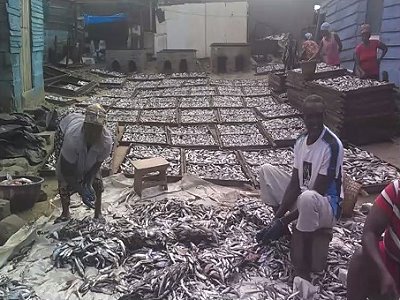 Jeppe Kolding focused on inland water fish production in Africa which he said had increased by 3.5% per year according to FAO data, but was largely under-reported. He showed the energy transfer pyramid illustrating that only approximately 10% of the energy is passed from one trophic level to the next while most of the energy at each level is needed for maintaining life functions. In other words, zooplankton feeding on minute aquatic plants represent about 10% of the plant biomass and babies of large fish and fish remaining small throughout their lifetime represent about 10% of the biomass of zooplankton and so on. As bigger fish eat smaller ones, he argued in favour of reducing bigger fauna which could feed on small fish and rather catch small fish, including juveniles of big fish, to produce more food for poor people on the assumption that poor people should only eat small fish.
Jeppe Kolding focused on inland water fish production in Africa which he said had increased by 3.5% per year according to FAO data, but was largely under-reported. He showed the energy transfer pyramid illustrating that only approximately 10% of the energy is passed from one trophic level to the next while most of the energy at each level is needed for maintaining life functions. In other words, zooplankton feeding on minute aquatic plants represent about 10% of the plant biomass and babies of large fish and fish remaining small throughout their lifetime represent about 10% of the biomass of zooplankton and so on. As bigger fish eat smaller ones, he argued in favour of reducing bigger fauna which could feed on small fish and rather catch small fish, including juveniles of big fish, to produce more food for poor people on the assumption that poor people should only eat small fish.
Martin Pastoors reported that his company was catching small pelagics in the NE Atlantic, the South Pacific and off West Africa in the cheapest and most efficient way possible and was selling the frozen product in Africa and Asia.
The discussion focused a lot on the evolution of the fisheries and how a situation had arisen that most of the Peruvian anchoveta production - although food grade - was allowed to be reduced to fish meal while a good part of domestic consumption was from aquaculture and imports. It also touched on issues of environment management, social justice and distributional policies.
Session 2 Processing
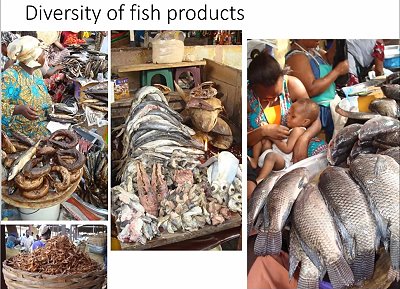 Moderated by Derek Johnson, University of Manitoba, Canada, and team leader of the Dried Fish Matters Project, the speakers were: Ragnhild Overa, University of Bergen, Norway; Benjamin B. Campion, Kwame Nkrumah University of Science and Technology, Ghana; Marian Kjellevold, University of Bergen/Institute of Marine Research; and Lyndon Paul, Danish Care Foods. Co., Ltd. Cambodia.
Moderated by Derek Johnson, University of Manitoba, Canada, and team leader of the Dried Fish Matters Project, the speakers were: Ragnhild Overa, University of Bergen, Norway; Benjamin B. Campion, Kwame Nkrumah University of Science and Technology, Ghana; Marian Kjellevold, University of Bergen/Institute of Marine Research; and Lyndon Paul, Danish Care Foods. Co., Ltd. Cambodia.
Ragnhild Overa started the presentations with a report about reported about field experience in Ghana with processing of small pelagics, both locally caught and imported, as well as tilapia both farmed and wild caught. Quickly deteriorating product quality was a constant challenge for processors and traders. Some chemicals were used to increase shelf life.
She commented on the strong informal institutions supporting smooth transactions. In each community there was an ohemma (queen mother) who oversaw credit relations. Only if her authority was insufficient a council of elders would fine misdemeanour.
She strongly recommended involving trader associations in governance processes with the government and investors. There was significant scope for improving processing and marketing conditions for women in postharvest activities and involving them more directly in the process.
Benjamin Campion listed a history of well-intended attempts to introduce higher performance smoking kilns to the fish processing women in different places. Hardly any modifications to the locally developed models had been accepted.
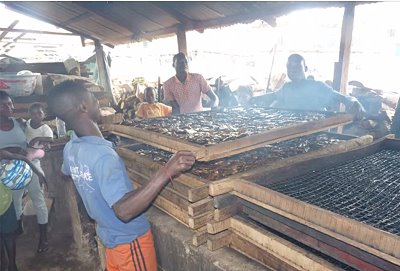 A questionnaire administered to processors and traders on the coast and up country showed that cost and speed of smoking were the two dominant choice criteria, while health protection, reduced wood consumption and other proposed innovations did not lead to uptake even in situations where subsidies and accompanying training had been offered. Conclusion: technologies will only work when people demand them.
A questionnaire administered to processors and traders on the coast and up country showed that cost and speed of smoking were the two dominant choice criteria, while health protection, reduced wood consumption and other proposed innovations did not lead to uptake even in situations where subsidies and accompanying training had been offered. Conclusion: technologies will only work when people demand them.
Mariam Kjellevold reported that despite a high per capita fish consumption in Ghana of 25 kg per year, pockets of malnutrition existed. Some food composition analyses had been carried out identifying e.g. nutrient losses during smoking and selected deficits of micronutrients.
The results suggested e.g. that none of the fish species marketed locally were providing sufficient levels of vitamin A by themselves and many of the traditionally smoked fish had high levels of polycyclic aromatic hydrocarbons (PAH) if not peeled before consumption. The sampling gave some pointers to useful follow-up, but did not suggest generally bad nutrition.
Lyndon Paul addressed a different market segment in Cambodia. He pointed out that while the country had the highest per capita fish consumption in the world according to FAO data, the access to that healthy food was skewed. Indeed, it was estimated that 46.8% of women in reproductive age were malnourished and 32.4% stunted. His company had developed a product based on fish powder, beans and other ingredients to complement diets which seemed to help fight malnutrition.
Much of the discussion turned on the difficulty of finding acceptable technical innovations.
Session 3 Consumption behaviour
Maarten Bavinck moderated the session with partners of the Fish4Food Project. The speakers were: Froukje Kruijssen, KIT Royal Tropical Institute, Amsterdam, Netherlands; Ben Belton, Michigan State University, USA, and WorldFish; Akosua K. Darkwah, University of Ghana; Amalendu Jyotishi, Azim Premji University, Bangalore, India; Kyana Dipananda, University of Amsterdam; and Thijs Schut, University of Amsterdam.
Froukje Kruijssen drew attention to observations how social norms influenced consumer behaviours and how urbanisation with associated life style changes impacted preferences for convenience food. She underlined how important it was that pregnant and lactating women and infants in the first 1000 days of their lives had access to a nutritious diet securing health and full cognitive development.
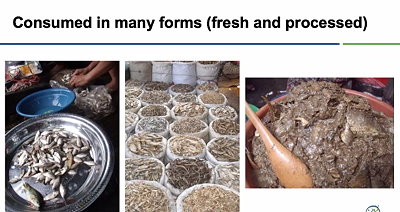 Ben Belton spoke about artisanal fisheries for small, low-cost freshwater and marine fish in Bangladesh, Myanmar and India. They were consumed fresh or processed in a wide variety of forms. Freshwater fish was getting scarcer as a result of habitat conversion and infrastructure construction, e.g. upstream damming of the Tonle Sap in Cambodia. Ensuing price increases led to substitution of preferred species with aquaculture products and less preferred small marine fish. Heavy fishing pressure and competition between artisanal and industrial marine fishers and diversion of catches into fish meal made it increasingly probable that marine harvests would also become outpriced for financially poor people.
Ben Belton spoke about artisanal fisheries for small, low-cost freshwater and marine fish in Bangladesh, Myanmar and India. They were consumed fresh or processed in a wide variety of forms. Freshwater fish was getting scarcer as a result of habitat conversion and infrastructure construction, e.g. upstream damming of the Tonle Sap in Cambodia. Ensuing price increases led to substitution of preferred species with aquaculture products and less preferred small marine fish. Heavy fishing pressure and competition between artisanal and industrial marine fishers and diversion of catches into fish meal made it increasingly probable that marine harvests would also become outpriced for financially poor people.
Akosua Darkwah reported on work she had carried out together with John Armah on food habits in Jamestown. The common staple was kenkey, based on ground up maize or, earlier, millet, which was always eaten in combination with small fish. As ingredients became more expensive portions where slightly diminished. She considered that this was not an issue as nutritionists were already advising to reduce the carbohydrate intake of the diet. The question was rather whether there would be fish in the future in the light of overfishing and the construction of a huge harbour on the site where small-scale fishers were operating so far.
Amalendu Jyotishi noted that average per capita fish consumption in India was merely 5 kg per year, just 25% of the global average according to FAO estimates (2018). As cities attract huge numbers of poor people from rural areas, it was feared that they could only access fish through markets and that this might restrict consumption. He then explored the differences in fish consumption between Chennai, a coastal city in SE India, and Bangalore situated inland. It turned out that the low income districts studied had similar levels of fish consumption because of taste and because people were aware of the nutritious value. In Chennai marine fish was strongly preferred to freshwater fish. Mobile vendors and nearby markets played a big role in accessibility in both cities.
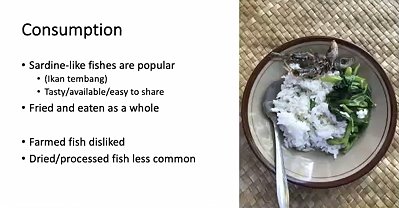 Kyana Dipananda had studied access, processing practices and perceptions of fish as food in Madura, a rural area in East Java Province, Indonesia. Fish is a regular part of the diet, mostly boiled. It is characterised as cheap, healthy and tasty. However, cheap fish are only seasonally available. Size and quality of fish matter to people. Bigger fish is "good to eat". Ease of preparation influences choice of species as well. Workers from Madura migrating to urban areas e.g. as shop keepers tend to change to convenience food.
Kyana Dipananda had studied access, processing practices and perceptions of fish as food in Madura, a rural area in East Java Province, Indonesia. Fish is a regular part of the diet, mostly boiled. It is characterised as cheap, healthy and tasty. However, cheap fish are only seasonally available. Size and quality of fish matter to people. Bigger fish is "good to eat". Ease of preparation influences choice of species as well. Workers from Madura migrating to urban areas e.g. as shop keepers tend to change to convenience food.
Thijs Schut studied fish consumption in rural Sumba, Indonesia, and found small fried fish with rice and vegetables was much preferred to cultured fish. Dried fish was rare. Mobile traders play a major role in supplies, sometimes on credit, without which poor people would not have access. Development policies from the capital consider this backwards and promote "modern" aquaculture products.
The discussion about the different case studies highlighted that a one size fits all policy would be highly misplaced. It also dampened the view that central government policy would be the most important factor to analyse and inform as the strength of the informal market channels often worked very efficiently and should not be underestimated. It was noted that urbanisation processes led to changes in food habits.
Session 4 Distribution and trade
The session was moderated by Holly Hapke, University of California, Irvine, USA. The speakers were: Anderson Kwasi Ahwireng, University of Amsterdam, Netherlands; Sharon Suri, University of Amsterdam; V. Vivekanandan, FishMARC, India; Moenieba Isaacs, University of Western Cape, South Africa; and Joeri Scholtens, University of Amsterdam.
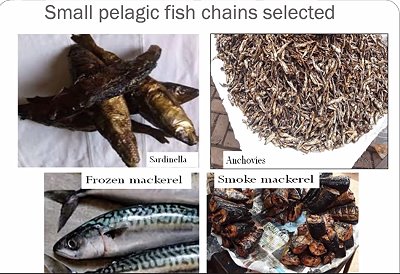 Anderson Kwasi Ahwireng shared results from his PhD research into trading patterns of locally caught and imported fish from the coast into the hinterland. Local fish caught and landed all along the coast are mostly are Sardinella maderensis, S. aurita, anchovy (Engraulis encrasicolus), Atlantic chub mackerel (Scomber colias). In the absence of available refrigeration infrastructure conservation is principally by smoking and drying.
Anderson Kwasi Ahwireng shared results from his PhD research into trading patterns of locally caught and imported fish from the coast into the hinterland. Local fish caught and landed all along the coast are mostly are Sardinella maderensis, S. aurita, anchovy (Engraulis encrasicolus), Atlantic chub mackerel (Scomber colias). In the absence of available refrigeration infrastructure conservation is principally by smoking and drying.
The primarily female traders take the products in all kinds of available containers - sacks, baskets, boxes - and vehicles either to the wholesale market in Accra, the most important in the country, or in the case of smoked fish already up country to the Tamale regional market for further onward sale. Imported fish landed frozen in Tema and Takoradi is either handled along cold chains and reaching the cold storage in Tamale or entering the smoked fish circuits and joining locally fished product chains. Fish mothers are often boat owners and prefinance fishing trips so that the fishers are obliged to sell catches to them at a discount. Big traders keep excess fish for release during the lean season when prices go up, even though there are quality and food safety concerns about produce treated with DDT or formalin to avoid insect infestation.
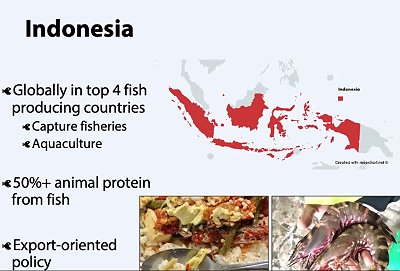 Sharon Suri had spent six months interviewing fish traders in Indonesia. Toke traders prefinance often small traders. Along-Along mobile traders connect to customers in places far from markets. The entire value chain is credit-driven, even customers can often access fish only against credit in the lean season. The mobile traders are key to access to fish food for poor customers. They themselves deal with the inherent uncertainties by reducing prices to avoid spoilage, extend credit and carry an entire assortment of food to balance out any losses in one commodity.
Sharon Suri had spent six months interviewing fish traders in Indonesia. Toke traders prefinance often small traders. Along-Along mobile traders connect to customers in places far from markets. The entire value chain is credit-driven, even customers can often access fish only against credit in the lean season. The mobile traders are key to access to fish food for poor customers. They themselves deal with the inherent uncertainties by reducing prices to avoid spoilage, extend credit and carry an entire assortment of food to balance out any losses in one commodity.
V. Vivekanandan painted a detailed picture of the mostly female fish vendors who usually are one-person businesses selling as much as they can individually per day through door-to-door selling or on way side markets. While these women had formerly bought their fish from the fisher husbands or other male family members the changes in the structure of the industry obliged them now to buy from more distant wholesale markets, often against informal credit. This has become essential for many families as men's incomes are decreasing because of competition with bigger boats and weather related some 100 days at sea, while the women can work 300 days a year to generate at least some income.
He collected many grievances of these women, but also found little policy attention to their condition. Few attempts at support had worked as expected because the real needs and priorities of the women had not been taken into account. In conclusion he argued for rights-based collective action to defend the social and economic rights of these vulnerable groups and suggested that forming cooperatives could help give them also a voice in political processes.
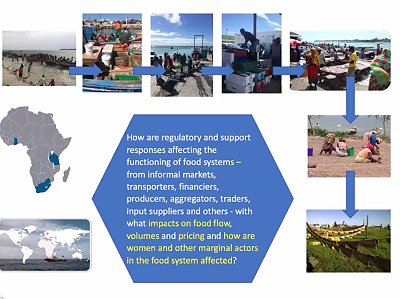 Moenieba Isaacs analysed small-scale fisheries in the context of other food systems in times of covid with emphasis on three African countries, South Africa, Zimbabwe and Nigeria. Government measures had been uneven with some government support to small agriculture producers, but usually not to small-scale fishers.
Moenieba Isaacs analysed small-scale fisheries in the context of other food systems in times of covid with emphasis on three African countries, South Africa, Zimbabwe and Nigeria. Government measures had been uneven with some government support to small agriculture producers, but usually not to small-scale fishers.
She concluded that while many economic activities were digitising their businesses that was hardly the case in various segments of the food systems she had looked at. It was considered useful to support informal food supply channels to poor and vulnerable populations and also repurpose and reimagine how the fish supply chains could function in the future under such conditions.
She called for regulations in favour of low-cost, nutrition-rich food for local consumption rather than export. She also suggested that governments could purchase fish from small-scale fisheries as supplies to schools, hospitals and prisons.
 Joeri Scholtens started his talk reminding the audience of global trends. FAO estimated that some 18 million tons of fish had been reduced to fish meals and oils (FMFO) in 2018, an upward trend since 2014. Some 69 percent of the resulting 5+ million tons were destined to aquaculture in the face of its ongoing expansion.
Joeri Scholtens started his talk reminding the audience of global trends. FAO estimated that some 18 million tons of fish had been reduced to fish meals and oils (FMFO) in 2018, an upward trend since 2014. Some 69 percent of the resulting 5+ million tons were destined to aquaculture in the face of its ongoing expansion.
Most of the fish reduced to FMFO is human food grade.
India was witnessing a particularly rapid expansion of shrimp aquaculture (introduced Lithopenaeus vannamei) for export. That expansion required by now almost one third of official landings to be turned into fish meal for that industry. This concerned both artisanal fisheries catches of small fish and industrial catches.
This meant a significantly reduced share of small-fish catches was available for local human consumption. Moreover, big dealers were making long-terms deals and squeezing out out local dealers, even if these could have paid higher prices.
Joeri Scholtens reported that the export-oriented fishmeal sector was highly subsidised and politically protected. He found that the on-going, yet little visible revolution was accompanied by effective messaging in the media. Fishmeal was described as a great way to get a high value product and that it rescued large quantities of fish from being wasted. In reality the on-going redistribution of fisheries resources away from human consumption to export for rich consumers amounted to nothing less than a reduction in food security, particularly of financially poor Indians.
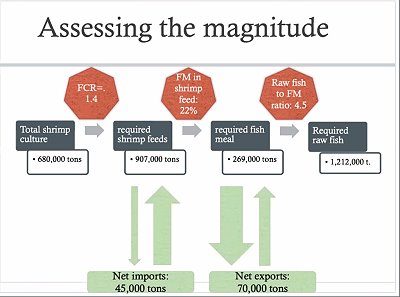 |
 |
Session 5 Collecting the threads
In the concluding session, Molly Ahern of FAO extracted some key challenges to sustainable fish food systems from the previous presentations and discussions. She mentioned, among others, the challenge to maintain quality and reduce post-harvest losses, the need to support women processors and traders with long-term skill enhancement and access to credit as they make up a very significant part of the protagonists along the value chains, but tend to work under particularly difficult conditions. That might also facilitate uptake of innovations which do not lead to displacement by financially stronger investors. Greater attention to informal markets and trading and reducing inequalities in access and consumption was warranted. At the same time, urbanisation and associated changes in diets were leading to unintended reduction of intake of nutrious fish food.
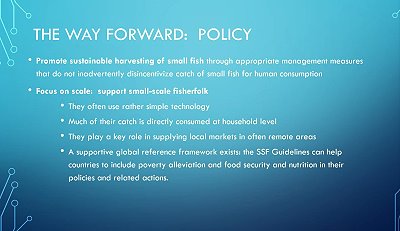 Only a few comments by speakers can be included here. Maarten Bavinck, one of the key organisers highlighted a social science perspective underlining that it was important to research the different contexts and not jump to conclusions, always using a human rights approach with a focus on the most vulnerable segments of the population. How can governance systems evolve that they prioritise small-scale fisheries in line with the SSF Guidelines and prevent e.g. the ethically inacceptable choice between food for people or feed for aquaculture. That had to go hand in hand with preventing SSF products becoming priced out of reach of financially poor consumers.
Only a few comments by speakers can be included here. Maarten Bavinck, one of the key organisers highlighted a social science perspective underlining that it was important to research the different contexts and not jump to conclusions, always using a human rights approach with a focus on the most vulnerable segments of the population. How can governance systems evolve that they prioritise small-scale fisheries in line with the SSF Guidelines and prevent e.g. the ethically inacceptable choice between food for people or feed for aquaculture. That had to go hand in hand with preventing SSF products becoming priced out of reach of financially poor consumers.
V. Vivekanandan echoed these concerns commenting that many local organisations he interacted with in India had a rather poor understanding of larger dynamics in the sector. Supporting their organisations or getting them organised if they weren't was crucial for improvements. Partnerships with civil society organisations and researchers were among the useful responses to these gaps. He strongly argued for carrying out joint pilot projects and experimenting before trying to scale. That would be an adequate risk management strategy.
The entire seminar was recorded and will shortly be made available for viewing on YouTube.








